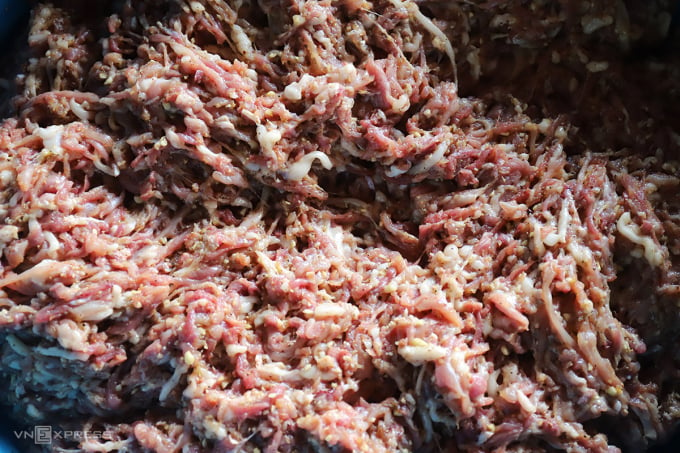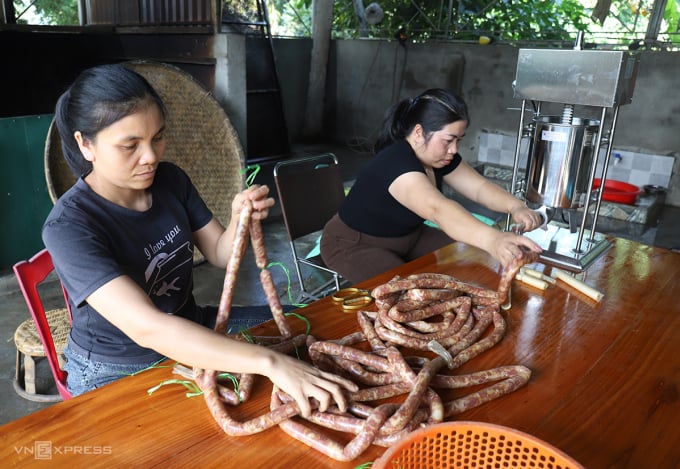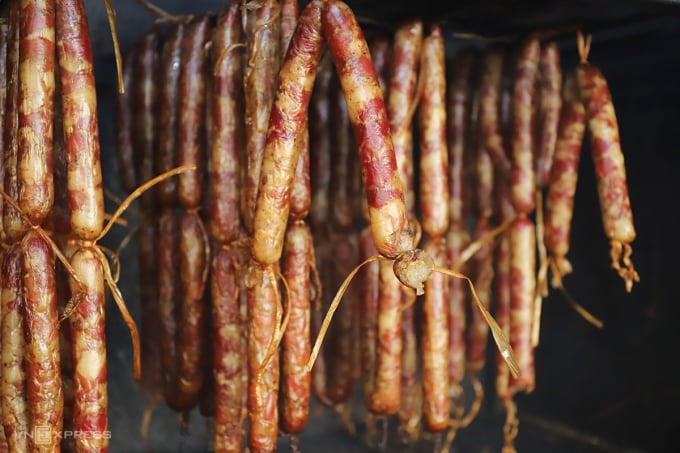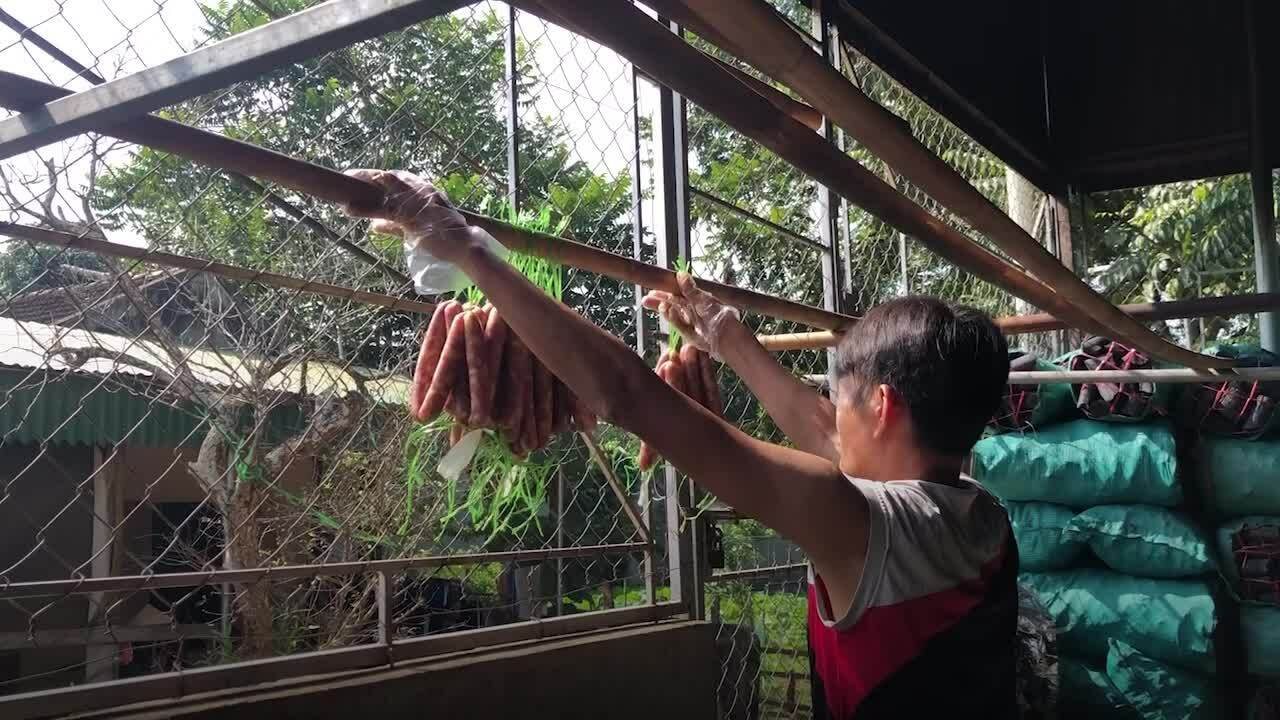Nghe An Hundreds of households in the mountainous districts of Quy Chau and Que Phong are busy producing smoked sausages to sell in time for the Tet holiday.
On a mid-January morning, Ms. Truong Thi Bao, 38 years old, and four other workers gathered to slice pork at her home in Chau Hanh commune, Quy Chau district. Near Tet, Ms. Bao's facility received thousands of orders for sausages from inside and outside the province. Every week, she bought 800 kg of meat, double the usual amount.

Pork is chopped and marinated before being put into collagen casing or small intestine to make sausage. Photo: Duc Hung
To make sausage, Ms. Bao chooses pork thighs and shoulders with a balanced amount of lean and fat. If the fat is thick, she has to cut it down to achieve a ratio of 20% fat and 80% lean. Next, she will cut the meat into thin strips and mix it with MSG, salt, soup, pepper and the facility's special spices, marinating for an hour.
"Choosing meat and seasoning is the most important step. If you choose a piece with a lot of fat or lean meat, it will feel boring or dry when eaten. If the seasoning is not mixed evenly, is too salty or too bland, the product will lose its aroma," said Ms. Bao.
After being marinated, the meat will be stuffed into cleaned pig intestines or collagen casings. Previously, Ms. Bao often did it manually, stuffing the meat by hand, making 20-30 kg of fresh sausages per day. For the past 7 years, the family has bought a meat stuffing machine to increase productivity. When the meat is put into the hopper, the motor will push the meat slowly into the pig intestines or collagen casings, and hundreds of kg of sausages can be produced per day.
When stuffed into collagen casings, the meat will create fresh sausages that are more than 2 meters long. Ms. Bao and another woman sit in front of the machine, tying each piece into 20 cm pieces to cut into convenient packaging later. Ms. Bao's husband takes each sausage string, hangs it on a bamboo tree, and takes it out to the yard to dry in the sun for a few hours before hanging it up in the kitchen.

Ms. Bao (right corner) and a worker are adjusting the machine to create fresh sausage. Photo: Duc Hung
The final step is to dry the sausage on the stove. Ms. Bao often buys longan and gasoline firewood to ensure safety and create a distinctive aroma. Each batch is dried for 4 days, then cut, packaged, vacuum-sealed, and stored in the refrigerator. The finished sausage is 20 cm long, 2.5 cm in diameter, packaged in packages of 8-16 pieces, weighing 0.5-1 kg.
"The hanging stage also determines success or failure. A drying rack can dry 300-400 kg of sausages. I have to constantly watch the stove to adjust the fire, so that the product's shell is dry but the inside is not hard to meet the standard," said Ms. Bao. Currently, sausages are sold for 300,000-350,000 VND per kg.
Normally, Ms. Bao makes a batch of about 300-400 kg of sausages a week. Near Tet, the facility produces two batches a week, about 800 kg. Previously, she hired one worker, now she has 5 more, paying 200,000-300,000 VND a day. After deducting expenses, the family makes a profit of 150-200 million VND during Tet.

Sausages drying on the stove at Ms. Hien's facility. Photo: Duc Hung
In Kim Son town, Que Phong border district, Ms. Nguyen Hien, 40 years old, along with dozens of large and small business owners in the area also mobilized dozens of seasonal workers to work overtime to produce batches of sausages to serve the Tet Giap Thin.
According to Ms. Hien, sausage is a traditional dish of the highland people. During Tet, every family prepares 3-5 kg to serve guests, so the products are always "sold out". She expects the next two weeks to be the hardest because her partners are constantly urging her, she will definitely have to work through the night, about 500-600 kg per week.
"To prepare Chinese sausage, just fry it or put it in an air fryer at 160-180 degrees Celsius, and it's ready to eat after 5 minutes," said Ms. Hien. A quality product is when the fatty meat is cut into a clear color, chewy and has a rich taste. When eating, you should add some raw vegetables to reduce the feeling of fullness.
The sausage making profession of the people in the highlands of Nghe An. Video : Duc Hung
Mr. Cao Minh Tu, Deputy Director of the Department of Industry and Trade of Nghe An province, said that sausages are produced seasonally by people in the mountainous areas. During the peak of Tet holiday, hundreds of families make them, while on normal days, only a few dozen households do it.
"The Department has directed districts to help business owners promote sales to many provinces and cities in the country, and connect with supermarket chains and distributors. However, input is still a bit difficult because there are not many products," said Mr. Tu.
Source link




































































































Comment (0)